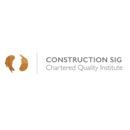Design Best Practice Self-Assessment Tool
Access the latest version of the Design Best Practice Self-Assessment Tool here.
Contents |
[edit] Background
Typically today:
- Construction projects have many quality metrics for the delivery phase but Clients have very few metrics for the Concept and Developed design stages of their projects.
- Evidence from projects, supported by analysis by the GIRI (Get It Right Initiative) in the UK, shows that the average construction project overruns its budget by 20% with worst case examples being 3-400% with time overruns of many years. The analysis concluded that many project quality issues have their root cause in the design stages of a project. Both the Client and the Architect processes often have a significant bearing on these issues.
In 2020, the Chartered Quality Institute published a piece of Quality guidance called the Construction Project Lifecycle which laid out the key Quality steps required to maximise the chance of success in construction projects. This guidance sparked wide interest and positive comments around the world. These interested people felt that more guidance about Quality Best Practices in the design stages of projects would be an extremely useful guidance tool.
[edit] The Best Practice Tool
This Quality Best Practice Self-Assessment tool (for Concept and Developed Design Stages) has been developed by a small group of leading quality experts from America, Australia, Canada & the UK, from a tool developed in the UK Airport Infrastructure industry.
The tool is aimed primarily at Construction Clients but can be used by Architects or Construction companies involved in the Concept and design stages of a project.
The belief is that use of this tool can significantly reduce the risks faced in projects by following well proven best practices developed from around the world. This will lead to major cost avoidance, timely delivery, and enhanced reputations.
[edit] When should this Tool be used?
The tool should be used during the Concept Design and Developed Design stages of a project (as defined by UK's RIBA organisation). Sometimes called Options and Scheme design stages.
The starting point is the Business Case approval Gateway (or some kind of project kick off decision.) That is: - a Client/Owner has had an idea, decided that it should be explored and set aside the necessary funds to develop a more detailed proposal.
At the end of the Concept stage, there may be a Recommended Option Approval Gateway before the commencement of the Developed Design Stage. On lower risk projects, this may also include funding for the entire project.
At the end of the Developed Design Stage, it is likely that the more detailed cost and schedule would be used to seek approval for the funding of the entire project.
After this (and not covered by this guidance) the project would move to production design, delivery stages and then to Handover and Operation/Maintenance.
[edit] How is the tool used?
The Tool is a subjective assessment of project progress made by the Project Manager, Quality Manager and a PMO representative.
It takes about 1-2 hours to complete and should be undertaken three times during each stage of the project.
The tool outputs a ‘percentage complete’ score. Experience has shown that projects with acceptable levels of risk have scores well over 90%. Any score lower than this should prompt many questions and careful risk assessment.
Access the tool here:
[edit] Contributors
Original work commissioned by Heathrow and lead by Helen Soulou with much input from Arup, Atkins and Jacobs.
The subsequent development of the tool has been undertaken by:
- Anita McReynolds Lidbury Arcadis (USA)
- David Myers Shirley Parsons Project Services (UK)
- Felipe Maya CIH - Construction Innovation Hub (UK)
- Greg Wennerstrom Calgary Light Rail Project - Canada
- Jonny Montgomery Shirley Parsons Project Services (UK)
- Martin Andrews Martin Andrews Solutions (Australia)
- Zoran Stojanovski AECOM (Australia)
Original article written by David Myers on behalf of the CQI Construction Special Interest Group and approved for publication on 4th May, 2021.
Version 2 of the Design Best Practice Self-Assessment Tool was made available 26/3/2022.
--ConSIG CWG 23:30, 16 May 2021 (BST)
[edit] Related articles on Designing Buildings
- 5 Whys
- Annex SL
- CDM Regulations: a quality perspective
- Change control: a quality perspective
- Checking and approval in design - a quality management perspective
- Collaboration: a quality management perspective
- Cost of quality.
- Design freeze: a quality perspective
- Design: a quality management perspective
- Quality Checklist
- Quality culture and behaviours
- Quality management systems (QMS) - beyond the documentation.
- Quality manuals and quality plans
- Quality tools: fishbone diagram
- Stakeholder management: a quality perspective
Featured articles and news
Homes England creates largest housing-led site in the North
Successful, 34 hectare land acquisition with the residential allocation now completed.
Scottish apprenticeship training proposals
General support although better accountability and transparency is sought.
The history of building regulations
A story of belated action in response to crisis.
Moisture, fire safety and emerging trends in living walls
How wet is your wall?
Current policy explained and newly published consultation by the UK and Welsh Governments.
British architecture 1919–39. Book review.
Conservation of listed prefabs in Moseley.
Energy industry calls for urgent reform.
Heritage staff wellbeing at work survey.
A five minute introduction.
50th Golden anniversary ECA Edmundson apprentice award
Showcasing the very best electrotechnical and engineering services for half a century.
Welsh government consults on HRBs and reg changes
Seeking feedback on a new regulatory regime and a broad range of issues.
CIOB Client Guide (2nd edition) March 2025
Free download covering statutory dutyholder roles under the Building Safety Act and much more.
Minister quizzed, as responsibility transfers to MHCLG and BSR publishes new building control guidance.
UK environmental regulations reform 2025
Amid wider new approaches to ensure regulators and regulation support growth.
BSRIA Statutory Compliance Inspection Checklist
BG80/2025 now significantly updated to include requirements related to important changes in legislation.























